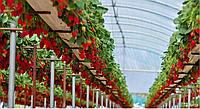Scientists are interested in enriching hydroponic strawberries with silicon for strong bones and against mineral starvation, as well as increasing the keeping quality of products. In search of an answer to one question, scientists have discovered an important player in the epiphytic microbial community on the surface of berries
A group of Italian scientists, while studying the prospects for biofortification of strawberries, determined the effect of silicon on the microbial community of berries, publishing the results in an article in the journal Agronomy 2021 on the MDPI portal.
“Mineral malnutrition is a phenomenon that affects two thirds of the world’s population in both industrialized and developing countries and has a profound impact on human health. Considering that strawberries are a popular product, enriching them with beneficial compounds looks like a promising solution to the problem.
In the case of fresh berries, fruits and vegetables, an increase in the content of beneficial compounds can be achieved either by improving genotypes, through breeding programs, or through the use of certain agronomic methods, for example, biofortification.
In particular, agronomic biofortification is achieved by supplying plants commonly grown in soilless production systems (such as hydroponics) with special mineral fertilizers aimed at increasing the concentration of a target nutrient in edible organs.
Strawberries consistently lead the berry world top. Garden strawberries are considered very valuable not only for their sensory characteristics, but also for their potential health benefits, as they are especially rich in antioxidant compounds such as vitamin C, anthocyanin, phenolic compounds and flavonoids.
However, strawberries do not store well after harvest due to their high metabolic rate, which causes rapid dehydration, loss of firmness, deterioration in color and tissue softness.
These problems lead to economic losses and the industry is constantly looking for ways to prolong the shelf life of strawberries.
To date, post-harvest methods aimed at extending the shelf life of berries have included either physical (high and low temperatures, irradiation and the use of a modified or controlled atmosphere) or chemical (fumigation, calcium dipping, coating, ozonation) methods and treatments.
However, the impact of the biofortification approach on the post-harvest life of strawberries is also noteworthy.
The amount of data collected over the past decades demonstrates that, among other micronutrients, silicon (Si) plays a fundamental role in promoting human health by participating in bone formation and mineralization.
Silicon, the second most abundant element in soil, is not essential to plants. However, the inclusion of Si in fertilization programs has shown positive effects on crops, improving resistance to biotic and abiotic stressors with increased yields.
In the context of biofortification, several studies have been carried out to increase the Si concentration in edible plant organs.
Based on the results, the best candidates were selected: strawberries, leafy vegetables and green beans.
Interestingly, the biofortification of strawberries led to differential modulation of biologically active compounds, namely, a decrease in the content of phenolic compounds and an increase in flavonoids.
In addition, various experiments have demonstrated that approaches to biofortification using mineral nutrients can also increase the shelf life of agricultural products.
The aim of this research work was to evaluate the effect of silicon biofueling of hydroponic strawberries on the keeping quality of berries after harvest.
Strawberry plants were grown under controlled conditions and an increasing concentration of Si was added in a standard nutrient solution. The strawberries were then evaluated for quality parameters (i.e. titratable acidity, hardness, Brix and sweetness) and storage was then simulated using different temperatures and time intervals.
In addition, strawberries were also evaluated for the composition of the epiphytic microbial community in order to find out if it could be influenced by the diet established for the plant, and in the specific case, by the Si biofortification program.
The results showed that biofortification did not significantly affect the hardness of the fruit, while at the highest Si levels, an increase in titratable acidity was observed.
Analysis of the microbial community for the first time revealed the presence of probiotic bacteria, namely: Bacillus breve, which may have interesting technological features in the form of strains adapted to the fruit sphere of strawberries.
In addition, as the level of Si biofortification increased, depletion of potentially pathogenic microorganisms such as Escherichia coli and Terrisporobacter glycolicus was also observed.









